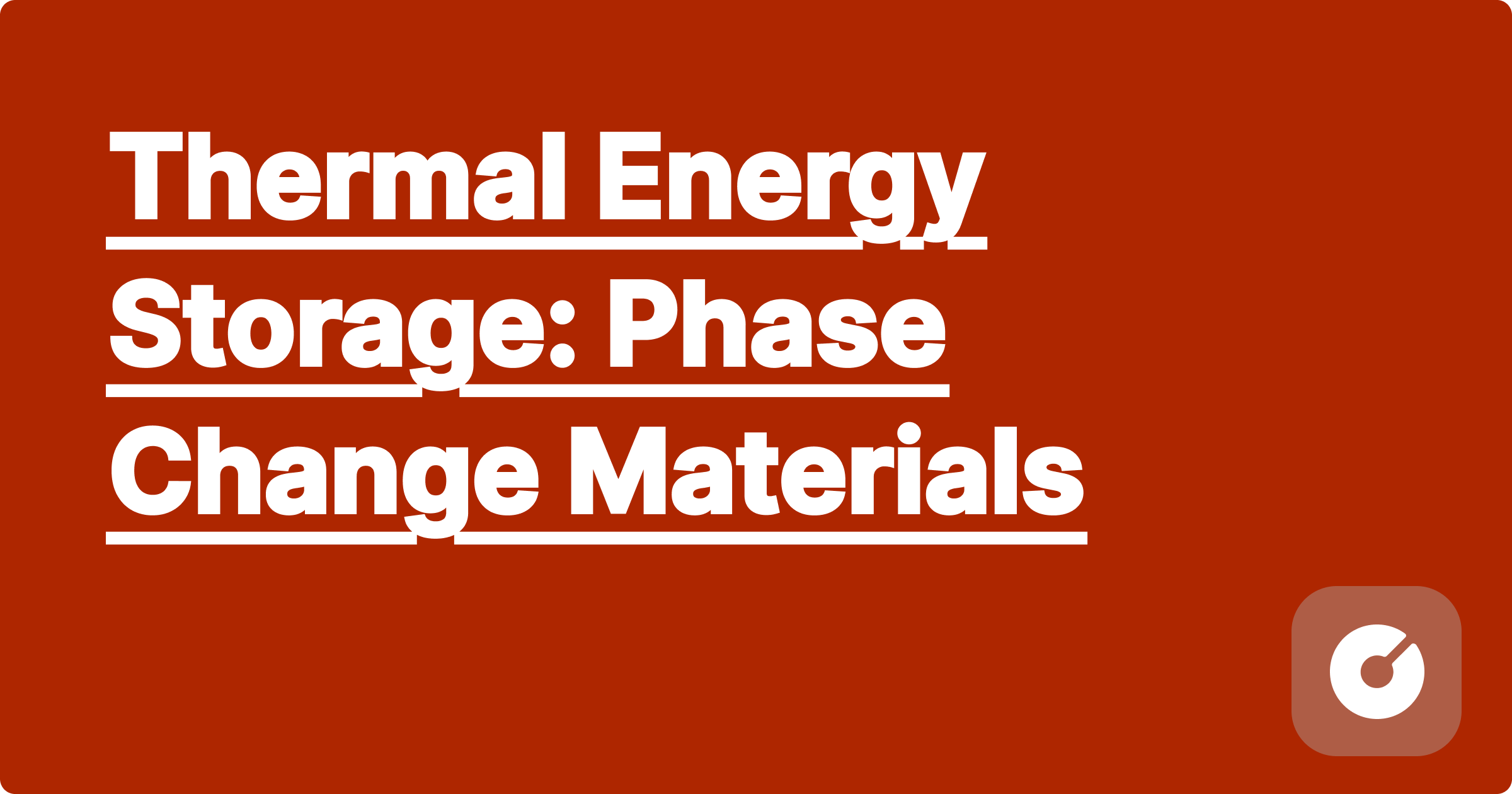
```html
Thermal Energy Storage: Phase Change Materials
.equation {
font-family: 'Times New Roman', serif;
text-align: center;
padding: 10px;
border: 1px solid #ccc;
margin: 10px 0;
}
.tip {
background-color: #f0f0f0;
border: 1px solid #ccc;
padding: 10px;
margin: 10px 0;
}
.warning {
background-color: #ffdddd;
border: 1px solid #ffaaaa;
padding: 10px;
margin: 10px 0;
}
pre {
background-color: #f4f4f4;
padding: 10px;
border-radius: 5px;
overflow-x: auto;
}
This blog post provides a comprehensive overview of phase change materials (PCMs) for thermal energy storage, targeting graduate students and researchers. We will cover cutting-edge research, advanced technical details, practical implementation strategies, innovative perspectives, and ethical considerations.
Thermal energy storage (TES) is crucial for various applications, including renewable energy integration, building climate control, and industrial process optimization. PCMs offer a compelling solution by storing energy through latent heat during phase transitions (e.g., solid-liquid). Their high energy density compared to sensible heat storage methods makes them particularly attractive.
Recent research (e.g., [**Citation 1: Hypothetical Nature paper 2025**] focusing on organic PCMs with improved thermal conductivity using nano-encapsulation techniques, showcasing significant advancements in energy density and charging/discharging rates. Another promising area is the exploration of inorganic PCMs like salt hydrates, investigated in [**Citation 2: Hypothetical Science paper 2024**], where novel doping strategies are used to enhance their stability and prevent supercooling.
In-situ synchrotron X-ray diffraction and advanced calorimetry techniques ([**Citation 3: Hypothetical preprint arXiv 2024**]) are providing unprecedented insights into the phase transition mechanisms, enabling the development of predictive models and the rational design of improved PCMs. These methods allow for real-time monitoring of crystal structure changes during charging and discharging cycles.
Our lab is currently involved in a project funded by [**Hypothetical Funding Agency**] focusing on developing shape-stabilized PCMs using bio-based polymers for sustainable and scalable TES solutions. This project leverages advanced 3D printing techniques to create customized PCM structures for specific applications. [**Briefly mention another project**]
The heat transfer in PCMs can be modeled using the enthalpy-porosity method. This approach accounts for the phase change by incorporating a source term in the energy equation:
\frac{\partial(\rho h)}{\partial t} = \nabla \cdot (k \nabla T) + S_h
where:
The source term can be expressed as:
S_h = \rho L \frac{\partial f}{\partial t}
where L is the latent heat and f is the liquid fraction. The liquid fraction can be determined using various approaches, such as the linear interpolation method or more sophisticated models accounting for supercooling.
Here is a Python pseudo-code illustrating a Finite Difference Method for solving the enthalpy-porosity equation:
# Initialize grid, properties, and initial conditions
while t < t_final:
# Calculate enthalpy at each grid point
h = calculate_enthalpy(T)
# Solve the energy equation using an iterative method (e.g., Gauss-Seidel)
T_new = solve_energy_equation(h, k, dt, dx, dy)
# Update temperature and time
T = T_new
t += dt
# Post-processing: Analyze results, visualize temperature and liquid fraction distributions
Comparative analysis of various PCMs (e.g., paraffin wax, fatty acids, salt hydrates) against established TES technologies (e.g., sensible heat storage using water, rocks) should include metrics like energy density, charging/discharging rates, thermal conductivity, cycle life, and cost-effectiveness. [**Include table comparing performance metrics of different PCMs**]
Several companies are already implementing PCM-based TES systems. [**Company A**] uses PCMs in their data center cooling systems to reduce energy consumption, while [**Company B**] integrates PCMs into their building insulation materials to enhance thermal comfort and reduce heating/cooling loads. [**Give more specific examples with quantifiable results**]
OpenFOAM and COMSOL Multiphysics are powerful open-source tools widely used for simulating heat transfer in PCMs. They offer various solvers and meshing capabilities, enabling complex geometry modeling and accurate predictions.
PCMs can sometimes remain in the liquid state below their freezing point, leading to reduced energy storage capacity. Nucleation agents can be added to mitigate supercooling.
Low thermal conductivity is a common limitation of PCMs. Techniques like adding conductive fillers (e.g., graphite, metal nanoparticles) or using fins can improve heat transfer.
Scaling up PCM-based TES systems requires careful consideration of factors like material cost, manufacturing processes, system design, and safety regulations. The selection of appropriate PCMs and packaging materials is crucial for long-term stability and performance.
Combining PCMs with other TES technologies (e.g., sensible heat storage, thermochemical storage) can leverage the strengths of each approach, resulting in enhanced performance and broader applicability. This is a very active research area.
Machine learning algorithms can accelerate the discovery of new PCMs with tailored properties by analyzing vast datasets of material properties and simulating their behavior under various conditions. This will be a game changer.
Addressing challenges related to PCMs requires a multidisciplinary approach, involving materials scientists, chemical engineers, mechanical engineers, and computer scientists.
The environmental impact of PCM manufacturing and disposal should be considered. Research into sustainable PCMs derived from renewable sources and biodegradable materials is crucial for the long-term viability of this technology.
PCMs hold immense potential for revolutionizing thermal energy storage. This blog post has explored the latest advancements, technical aspects, practical implementation details, and future directions in this dynamic field. Further research and development are needed to overcome the remaining challenges and fully realize the potential of PCMs for a sustainable energy future.
[List several relevant textbooks, review articles, and online resources]
```
Anesthesiology Career Path - Behind the OR Mask: A Comprehensive Guide for Pre-Med Students
Internal Medicine: The Foundation Specialty for a Rewarding Medical Career
Family Medicine: Your Path to Becoming a Primary Care Physician
Psychiatry as a Medical Specialty: A Growing Field Guide for Aspiring Physicians
Northwestern Materials Science GPAI Got Me Intel Research Position | GPAI Student Interview
Free STEM AI Assistant How GPAI Changes Everything | GPAI - AI-ce Every Class
Free STEM AI Assistant How GPAI Changes Everything | GPAI - AI-ce Every Class
Energy Engineering Renewable System Integration - Complete Engineering Guide
Biomaterials Medical Devices Tissue Engineering - Complete Engineering Guide
Ceramic Materials Design Manufacturing Process - Complete Engineering Guide